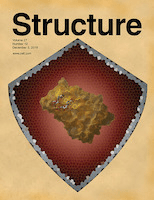
Biomolecular NMR Assignments
Scope & Guideline
Exploring the dynamics of proteins through innovative NMR techniques.
Introduction
Aims and Scopes
- NMR Spectroscopy Techniques:
The journal emphasizes various NMR techniques, including solution NMR, solid-state NMR, and magic angle spinning (MAS) NMR, showcasing advancements and applications of these methods in assigning resonance to biomolecules. - Biomolecular Assignments:
A central theme of the journal is the detailed assignment of backbone and side-chain resonances of proteins, nucleic acids, and other biomolecules, which is essential for elucidating their three-dimensional structures. - Structural Biology and Dynamics:
The journal integrates studies that explore the relationship between molecular structure and function, including dynamics and interactions of biomolecules, providing insights into biological processes at the molecular level. - Intrinsically Disordered Proteins:
A notable focus is on intrinsically disordered proteins (IDPs), which are crucial for many biological functions. The journal publishes assignments that help in understanding the properties and roles of IDPs in various cellular processes. - Disease-Related Studies:
Research related to disease mechanisms, particularly those involving viral proteins and oncogenic mutants, is frequently featured, highlighting the relevance of NMR assignments in drug design and therapeutic interventions.
Trending and Emerging
- COVID-19 Related Research:
A significant increase in studies focusing on the NMR assignments of proteins associated with SARS-CoV-2 and other coronaviruses has been observed, reflecting the global urgency to understand viral mechanisms and develop therapeutic strategies. - Protein-Protein Interactions:
There is a growing emphasis on studies investigating protein-protein interactions through NMR, which are crucial for understanding complex biological pathways and mechanisms. - Dynamic and Flexible Regions of Proteins:
Recent publications have shown an increased focus on the characterization of dynamic and flexible regions within proteins, particularly those that are intrinsically disordered, which are essential for understanding protein function. - Structural Studies of Membrane Proteins:
Emerging research on membrane proteins and their dynamics using NMR highlights the importance of these proteins in cellular signaling and transport, reflecting a broader interest in membrane biology. - Integration of Computational Methods:
The integration of computational modeling with NMR data to enhance structural insights and dynamics analysis is becoming more prevalent, indicating a trend towards interdisciplinary approaches in biomolecular research.
Declining or Waning
- Traditional Protein Assignments:
There appears to be a decrease in studies focusing solely on traditional protein backbone assignments without additional context, such as dynamics or interactions, as researchers increasingly seek to integrate functional insights into their work. - Static Structural Studies:
Static structural studies that do not incorporate dynamic or functional analyses are less frequently published, indicating a trend towards a more dynamic understanding of biomolecular interactions. - NMR Applications in Non-Biological Systems:
Research applying NMR techniques to non-biological systems or materials has diminished, as the journal increasingly prioritizes studies directly related to biomolecular applications.
Similar Journals

PROTEINS-STRUCTURE FUNCTION AND BIOINFORMATICS
Exploring the Interplay of Structure and FunctionPROTEINS - STRUCTURE FUNCTION AND BIOINFORMATICS, published by WILEY, is a leading journal in the fields of biochemistry, molecular biology, and structural biology, recognized for its significant contribution to protein research since its inception in 1986. With its impressive rankings in the Q1 category for Biochemistry and Q2 for both Molecular Biology and Structural Biology in 2023, the journal serves as an essential resource for researchers and professionals seeking to explore the intricate relationships between protein structures and their functions. The journal, based in the United States, operates without an Open Access model, ensuring a curated selection of high-quality peer-reviewed articles that drive innovation and collaboration in the scientific community. Engaging with the robust content of PROTEINS not only bolsters academic scholarship but also opens avenues for groundbreaking discoveries that are pivotal in the advancing field of bioinformatics.

JOURNAL OF MAGNETIC RESONANCE
Transforming Research into Practical Applications of Magnetic ResonanceThe JOURNAL OF MAGNETIC RESONANCE, a leading peer-reviewed publication from ACADEMIC PRESS INC ELSEVIER SCIENCE, serves as a vital platform for disseminating cutting-edge research in the fields of biochemistry, biophysics, and condensed matter physics. With an ISSN of 1090-7807 and an E-ISSN of 1096-0856, this journal is committed to publishing innovative studies that explore the principles and applications of magnetic resonance techniques. Ranking in the Q3 and Q2 quartiles across various categories in 2023, it reflects a robust standing within the academic community, especially noted for its contributions to nuclear and high energy physics where it ranks 29th out of 87 journals. The journal's comprehensive scope and emphasis on accessible research make it an essential resource for researchers, professionals, and students alike, facilitating advancements in both theoretical and practical aspects of magnetic resonance. With conversion years spanning 1997 to 2024, the journal continues to uphold its legacy as a cornerstone of knowledge in the best practices of scientific research.

Journal of Structural Biology-X
Advancing the Frontiers of Molecular ArchitectureThe Journal of Structural Biology-X, published by Elsevier, is a leading open-access journal dedicated to advancing the field of structural biology. Launched in 2019, it has quickly established itself as a vital resource for researchers, professionals, and students, boasting a prestigious Q1 ranking in Structural Biology for 2023 and achieving an impressive Scopus rank of #19 out of 49 in the biochemistry, genetics, and molecular biology category. With an E-ISSN of 2590-1524, this journal emphasizes accessibility and collaboration by providing open access to its comprehensive collection of research articles, reviews, and cutting-edge methodologies. The scope of the journal encompasses significant themes within structural biology, including protein structure, molecular interactions, and imaging techniques, facilitating interdisciplinary dialogue and innovation. Join the global community of scientists and contribute to the body of knowledge that propels our understanding of molecular architecture through the Journal of Structural Biology-X.

JOURNAL OF COMPUTATIONAL CHEMISTRY
Driving Discovery Through Computational ExcellenceThe Journal of Computational Chemistry, published by Wiley, is a premier platform in the fields of computational chemistry and computational mathematics. Established in 1980 and continuing through 2024, this journal serves as an essential resource for researchers, professionals, and students seeking to advance their understanding and application of computational methods in chemical research. With a commendable impact factor and ranking in the top quartile (Q2) for both Chemistry and Computational Mathematics, it boasts impressive Scopus rankings—22nd out of 189 in Computational Mathematics and 102nd out of 408 in General Chemistry, indicating its strong influence within these scientific communities. While it does not offer open access, the Journal of Computational Chemistry remains a vital venue for disseminating groundbreaking research and fostering collaboration in the computational science landscape. For those at the forefront of innovation, staying abreast of the latest findings published here is indispensable for advancing their work in theoretical and applied chemistry.

Carbohydrate Research
Unraveling the complexities of biomolecular structures.Carbohydrate Research, published by Elsevier Science Ltd, stands as a pivotal platform for advancing the understanding of carbohydrate chemistry and its applications, with fine coverage extending from 1965 to 2024. This esteemed journal, with an ISSN of 0008-6215 and E-ISSN 1873-426X, is positioned in the Q2 category for Analytical Chemistry and Organic Chemistry, and Q3 for both Biochemistry and Medicine (miscellaneous) as of 2023, reflecting its substantial impact within these disciplines. With a Scopus rank placing it in the 58th and 57th percentiles for Analytical and Organic Chemistry respectively, Carbohydrate Research attracts a diverse readership including researchers, professionals, and students keen on exploring the latest developments in carbohydrate science. Though it operates under a traditional publishing model, the journal fosters a rich environment for scholarly communication and innovation in carbohydrate-related research, making it an invaluable resource for those committed to unraveling the complexities of this essential biomolecule.

BIOCHIMICA ET BIOPHYSICA ACTA-BIOMEMBRANES
Pioneering Research in Biochemistry and BiophysicsBIOCHIMICA ET BIOPHYSICA ACTA-BIOMEMBRANES is a prestigious journal dedicated to advancing the field of biomembrane research, published by Elsevier. With a notable track record since its inception in 1967, this journal operates under the dual ISSN 0005-2736 and E-ISSN 1879-2642, and has firmly established itself within the scientific community by ranking in the top tiers of various disciplines, including Q2 in Biochemistry and Cell Biology, and Q1 in Biophysics as of 2023. Its impressive Scopus rankings further underscore its importance, with a rank of 24 in Biophysics reflecting its strong impact on ongoing research. Although it does not offer open access, the journal provides comprehensive insights and breakthroughs essential for scientists, researchers, and advanced students focused on biophysical and biochemical aspects of membranes. By disseminating pivotal findings, BIOCHIMICA ET BIOPHYSICA ACTA-BIOMEMBRANES contributes significantly to understanding cellular mechanisms, thereby serving as a vital resource for professionals aiming to explore the complexities of biological membranes.

Biomolecules
Illuminating the path of discovery in molecular biology.Biomolecules is a prestigious, peer-reviewed journal published by MDPI that has been dedicated to advancing the field of biochemical research since its launch in 2011. With an impressive impact factor positioning it in Q1 for Biochemistry and Q2 for Molecular Biology as of 2023, this journal serves as a vital platform for disseminating high-quality research findings related to biological macromolecules, including proteins, nucleic acids, and carbohydrates. Operating as an Open Access journal, it ensures that vital research is accessible to all, furthering knowledge dissemination and collaboration within the scientific community. Located in Basel, Switzerland, the journal has established a significant presence in major academic databases, holding commendable Scopus rankings in both Biochemistry and Molecular Biology. Researchers, professionals, and students will find Biomolecules an invaluable resource for cutting-edge research, reviews, and insights in the rapidly evolving domains of biochemistry and molecular biology.

STRUCTURE
Elevating understanding of life's molecular architecture.STRUCTURE is a premier academic journal published by CELL PRESS, dedicated to advancing the field of structural biology and molecular biology since its inception in 1993. With an impressive reputation, it is recognized as a Q1 journal in both Molecular Biology and Structural Biology categories, reflecting its high impact within the academic community. The journal holds a significant position in Scopus rankings, placing 10th among 49 in Structural Biology and 100th among 410 in Molecular Biology, marking it as a key resource with a strong influence on ongoing research. Researchers and professionals alike will find STRUCTURE an invaluable platform for disseminating cutting-edge findings related to protein structure, dynamics, and interactions, fostering insights that can lead to groundbreaking applications in medicine and biotechnology. Although the journal follows a traditional subscription model, it continues to attract a diverse array of submissions, ensuring a vibrant exchange of knowledge in the ever-evolving landscape of structural and molecular biology. Access to its content can enhance the understanding of intricate biological mechanisms, making it essential reading for experts, students, and anyone passionate about the molecular underpinnings of life.

PROTEIN SCIENCE
Unraveling the Mysteries of Protein Structure and FunctionPROTEIN SCIENCE, published by Wiley, is a premier journal dedicated to the field of biochemistry, molecular biology, and medicine, boasting an impressive impact factor that reflects its influence and importance within the academic community. Established in 1992, the journal has continuously provided a platform for high-quality research, with a current classification in the top quartile (Q1) for its critical contributions to the understanding of protein structure and function, as well as its applications in health and disease. With a Scopus ranking placing it in the 91st percentile among its peers, PROTEIN SCIENCE publishes cutting-edge studies and reviews that are essential for researchers, professionals, and students seeking to advance their knowledge in protein research. Although it does not currently offer open access options, the journal remains dedicated to disseminating vital findings that support the ongoing advancements in molecular biology and biochemistry. Researchers can count on PROTEIN SCIENCE for consistently rigorous peer-reviewed content that fosters meaningful dialog and innovation in the life sciences.

FEBS Open Bio
Championing transparency in the world of molecular science.FEBS Open Bio is a leading open-access journal published by Wiley, dedicated to advancing our understanding of biochemistry, genetics, and molecular biology. Since its inception in 2011, this journal has provided a robust platform for researchers to share their findings with a wider audience, ensuring the dissemination of high-quality scientific knowledge. With an impact factor reflecting its stature in its field, FEBS Open Bio is ranked #77 out of 221 in general biochemistry, genetics, and molecular biology, placing it in the 65th percentile among its peers. This journal serves as an essential resource for professionals, researchers, and students alike, fostering collaboration and innovation within the scientific community. The commitment to open access not only enhances visibility but also promotes transparency in research, making it a vital contributor to the ongoing dialogue in biochemical and molecular biological sciences. For those looking to stay at the forefront of research developments, FEBS Open Bio is a key publication addressing the latest trends and discoveries in the field.